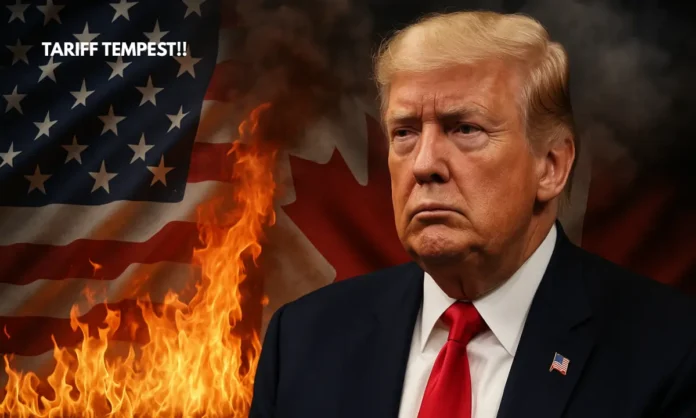Summary Box
- Trump imposes 35% tariff on Canadian imports, effective August 1, 2025
- Blanket 15-20% tariffs planned for most other trade partners
- Global markets brace for fallout as Canada weighs retaliation
A New Front in Trump’s Trade War Revival
The global economy is bracing for fresh tremors as U.S. President Donald Trump launches a new wave of tariffs targeting long-time allies and trade partners. In a dramatic escalation of his trade policy, Trump announced a 35% import tariff on Canadian goods, effective August 1, 2025. This decision, unveiled in a blunt letter to Canadian Prime Minister Mark Carney, threatens to upend one of the world’s most stable cross-border trading relationships. Simultaneously, Trump hinted at sweeping blanket tariffs of 15% to 20% on “most other” nations, rekindling fears of a global trade war that could rattle financial markets, disrupt supply chains, and test geopolitical alliances.
While details remain fluid, the White House appears poised to adopt a tariff-first approach reminiscent of Trump’s 2018-2019 trade war era. However, unlike that period, the geopolitical and economic stakes are higher in 2025, with the post-pandemic recovery still fragile, inflationary pressures mounting, and global debt levels historically elevated.
Trump announces 35% tariffs on Canada starting Aug. 1, warns of higher levies if Ottawa retaliates
— gtG (@g00dtoGreat) July 11, 2025
Published Thu, Jul 10 20258:32 PM EDTUpdated 2 Hours Ago pic.twitter.com/W6jnwSspT3
Canada in the Crosshairs
- 35% U.S. tariff on Canadian imports effective August 1, 2025
- Canadian retaliation could lead to spiraling tit-for-tat trade measures
- PM Carney faces diplomatic test balancing response with economic fallout
Canada, the United States’ largest trading partner in goods after China and Mexico, now finds itself on the receiving end of an abrupt economic strike. Trump’s announcement has not only shocked Ottawa but has also blindsided sectors reliant on cross-border commerce, from lumber and dairy to automotive parts and aluminum. While Prime Minister Mark Carney has yet to issue a formal response, sources suggest his administration is urgently evaluating countermeasures—including targeted retaliatory tariffs on U.S. agricultural and manufactured goods.
Trump’s letter warned that if Canada retaliated, “the new rate would go up.” The tone echoes prior threats during his first presidency, where punitive economic diplomacy often strained America’s traditional alliances. At stake now is not only trade volume—which surpassed $800 billion in 2024—but also the credibility of the United States as a reliable economic partner.
Blanket Tariffs: America vs the World?
- Trump confirms blanket 15%-20% tariffs for remaining countries
- Japan, South Korea, and others already face new levies
- Uncertainty looms over multinational supply chains
In an NBC News interview published Thursday, Trump revealed that not all nations would receive formal tariff letters. Instead, a blanket strategy will be implemented against most other trade partners. “We’re just going to say all of the remaining countries are going to pay,” Trump stated. Among the targeted nations are key U.S. allies Japan and South Korea, which are already contending with new copper and technology tariffs.
The unpredictability of these blanket policies is already generating anxiety across the global business community. Export-reliant economies such as Germany, Vietnam, and Brazil fear that overnight duties could destabilize bilateral ties and corporate planning. Meanwhile, American businesses dependent on global inputs worry about price shocks, margin squeezes, and retaliatory limitations on their own exports.
The Global Repercussions Begin
- Global stock indices show early signs of volatility
- Multilateral institutions warn of cascading economic risks
- U.S. midterm politics may influence tariff trajectory
Financial markets reacted cautiously on Thursday, with key indices dipping and commodity prices spiking. Multilateral bodies like the WTO and IMF have called for restraint, urging negotiation over escalation. The IMF in particular warned that “uncoordinated trade restrictions at this scale could shave a full percentage point off global growth by early 2026.”
Meanwhile, Trump’s aggressive tariff rollout is widely seen as a political strategy to shore up support among manufacturing-heavy swing states ahead of the 2026 midterms. The administration appears to be wagering that economic nationalism still resonates, despite signs that American voters are increasingly fatigued by inflationary aftershocks and disrupted goods availability.
Shockwaves, Not Stability
Trump’s tariff campaign may deliver short-term headlines but could also spark long-term damage. The proposed 35% Canada import levy is not merely a tax; it’s a declaration of economic confrontation aimed at both friends and competitors. The administration’s move could unravel two decades of North American trade cooperation built on the USMCA and NAFTA frameworks. With supply chains still healing from pandemic-era fractures, new tariffs risk injecting renewed uncertainty into an already fragile system.
The question remains: will the global community fold, retaliate, or attempt to renegotiate? One thing is certain—the world is once again recalibrating its expectations of America’s role in the economic order.


